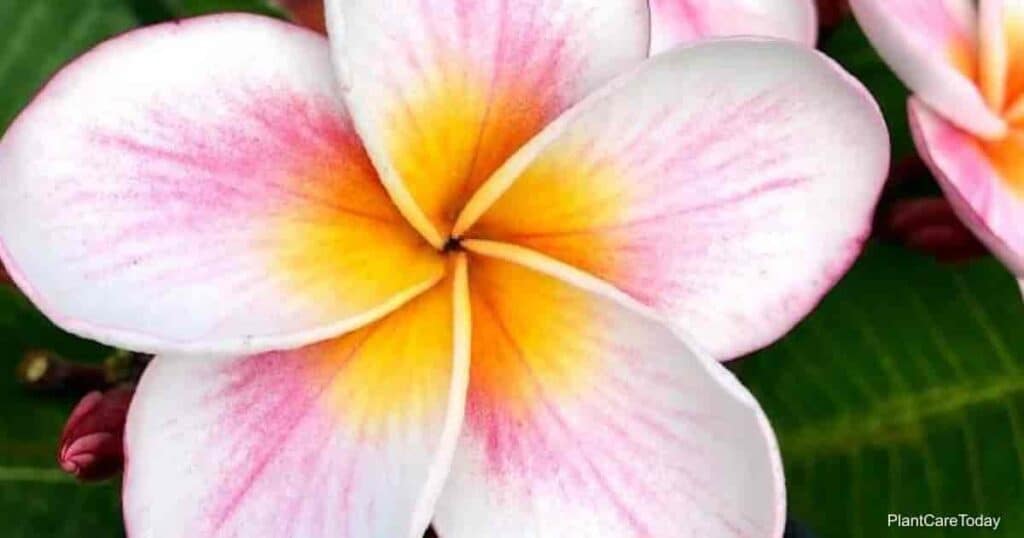There are eleven species in the genus Plumeria, a member of the Apocynaceae or dogbane family of plants.
These small trees or shrubs hail from Tropical America and have naturalized freely into the Pacific Islands and Asia.

These tropical plants will not tolerate excessively dry soil. They need consistent moisture in the soil, but soggy soil conditions cause root rot.
In this article, we share tips to help save your Plumeria if you have overwatered.
Read on to learn more.
How To Save An Overwatered Plumeria?
If your plant is seriously overwatered, you will be able to observe these signs:
- Wilted and yellowing leaves
- Sour-smelling soil
- Leaf loss
If your Plumeria is planted in the landscape, you may see that earthworms are struggling to the surface of the soggy soil to avoid drowning.
Even if root rot has set in, you may be able to save your plant. Your first step is to remove it from the soggy soil.
Here’s what you need to do:
- Clean the roots and examine them thoroughly.
- Look for any that are mushy or dark brown. These should be pruned off using a sharp, sterile cutting implement.
- Next, cut into the healthy root area above the damaged root. Your aim is to remove all parts that may be harboring fungus completely.
- Prune away dead and damaged stems and leaves as well.
- Allow the plant to air overnight to help the roots dry out.
Relocate Or Repot Your Frangipani
Outdoors: In an outdoor setting, prepare a new location with fresh, light, airy soil.
Be sure to choose a slightly elevated setting with good drainage and air circulation. It should receive at least half a day of bright sun.
Indoors: For indoor plants, pot into a completely new or sterilized pot with ample drainage holes.
Pots, such as terra cotta, are best made of natural, porous material.
Use a sharply draining potting medium consisting of a high percentage of perlite, pumice, or poultry grit. A commercially prepared cactus mix is a good choice.
Use Soak & Dry Watering
Here’s what you need to do:
- With your first watering, apply a dose of fungicide.
- Next, pour water through the soil, allowing it to run out of the drainage holes.
- Be sure all excess water has drained off before returning the plant to its saucer (if used).
- Never allow your Frangipani to stand in water.
When the top couple of inches of soil is dry, thoroughly water your plumeria again.
Will My Frangipani Survive?
Even with all the best intentions and techniques, your plant may die of root rot. Luckily, it is possible to take a little insurance to prevent being without a Plumeria plant.
These hardy tropical plants can easily be grown from cuttings, so when you prune your ill plant, look for healthy stems that you can use to start new plants.
Viable cuttings should be taken from areas of the plant with mature, woody stems, which can be identified by their grayish coloration.
So it’s important not to take younger cuttings, as green cuttings will not be successful. Be sure to include the tip of the stem.
A successful cutting should be about a foot long and have just a pair of leaves.
Here’s what to do after taking a cutting:
- Let the cutting lie out in the open air for several days to form a callus over the cut end.
- Put the cutting in a small container of potting mix (as described above). It should be sunk to a depth of about 3” inches.
- Water it thoroughly, and place it in a protected area that stays consistently warm and receives bright, indirect sunlight.
- Do not water again for 5 or 6 weeks.
Handle Frangipani Cuttings With Care
Take care when pruning your plant and handling the cuttings because these plants are related to Oleander, and like their cousins, they contain a toxic, milky white sap.
Be sure to wear gloves and eye protection. Wash up thoroughly when you are done handling your Plumeria plants.
